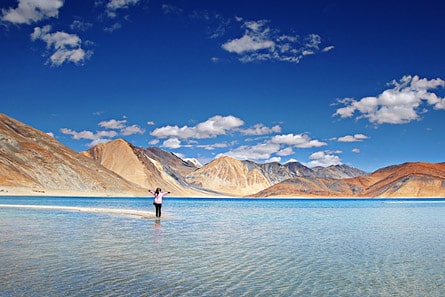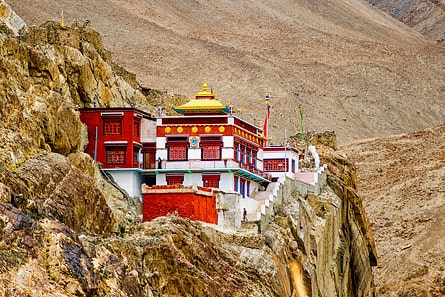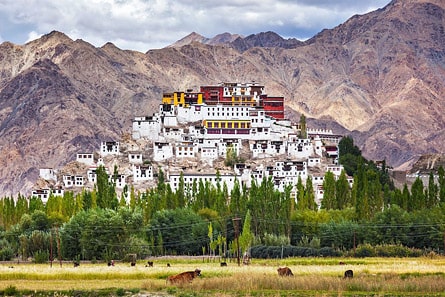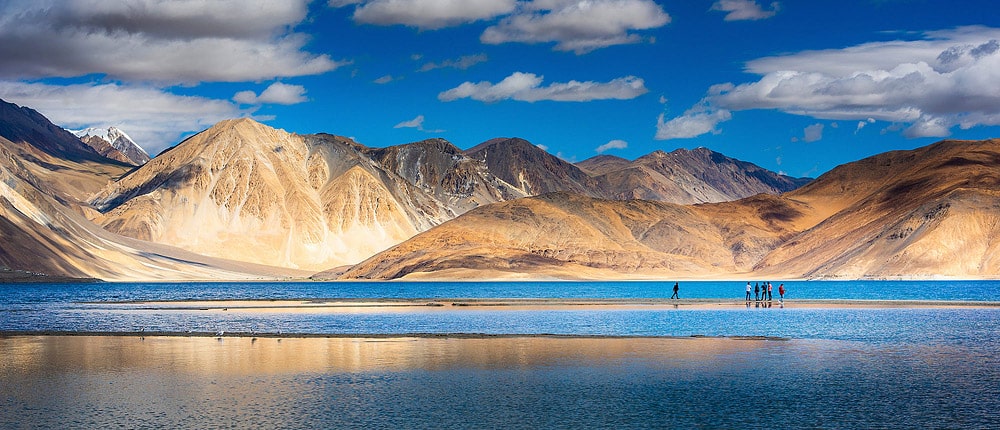

Pangong lake is a gem of the Ladakh region. This 140-kilometre-long salt lake is located at an altitude of 4,250 metres, 30% of the lake is in India whereas the other part is in Tibet. This Himalayan wetland reserve is an important breeding site for migratory birds. Spangmik is a small village on the bank of the lake where inhabitants rear pashmina goats.
To access Pangong lake, you will drive through Chang La pass which is one of the highest motorable passes in the world at an altitude of 5,360 metres above sea level. Then, you will pass through Tangtse, a pleasant village situated 35 kilometres from Pangong lake.
You can combine the Pangong lake tour with the visit to several monasteries in the Indus valley. You can visit Chemrey monastery, Hemis monastery, Thiksey monastery and Shey palace. If you have more time, you can include Stakna monastery and Stok palace in your itinerary.
The Pangong lake tour can be done in one, two or three days. It is recommended that you take at least two days for this tour so that you have time to visit the monasteries of the Indus valley:


Well, well, well! You are here. We bet you have heard and seen it all about Pangong lake, at least online or through movies such as the famous 2009 film “3 Idiots”. Now, you wish to pay a visit to the place of your fantasy, and we are here to guide you plan your tour in the best possible way.
Apart from Bollywood hysteria, people visit Pangong Tso for its exquisite natural beauty. You would often come across onlookers trying to see at least three to four hues of blue colour in this pristine water body of trans-Himalaya. You would find people mesmerized by its expanse and magnanimity. The earthy walls of barren mountains form a backdrop for this emerald lake, drawing visitors from all over the world.
However, from Leh, the capital of Ladakh, Pangong Tso is a long stretch. Wouldn’t you be keen on learning about what lies on its way? In this post, we are detailing those villages, sites and monasteries that you could enjoy before arriving at your destination.

Ladakh is home to many lakes and one of the most breathtaking lakes is Pangong Tso in the Changthang region. A world-renowned lake, because of its strategic importance and a picturesque landscape, Pangong begets its name from vernacular language meaning ‘high grassland’ and ‘Tso’ referring to ‘lake’.
Pangong Tso is situated close to the Indo-Tibetan border and Line of Actual Control. Interestingly, only one-fourth of the lake is in India and the rest in Tibet where it’s called Tso Nyak (the Black Lake). The lake is some 145 km from Leh. In recent years, many Bollywood movies have been shot around the lake. Similarly, due to its geopolitical position, it flashes in the media quite often. These factors have given Pangong Tso a prominence in the tourism industry. Thus, catapulting it to an essential destination for every visitor.
If we were to describe Pangong lake, the words seem to fail us. Hidden in the laps of snow-capped mountains and high-altitude plateaus, the lake juxtaposes the barrenness of the expanse with its deep emerald presence. Its richness in blue hue complements the yellowish strokes of the landmass it lays in. If you are fortunate enough, you might also witness the majestic strides of wild horses, the flights of conch-shell seagulls or the mating black-neck cranes!

Located on the banks of Pangong lake, Spangmik is a small settlement of Changpa nomads who subsist on agriculture and pashmina goats. The village is situated between Pangong lake and Thang Chenmo mountains close to the Chinese border. Due to its strategic importance, the Indian army keeps the village accessible. Therefore, it can be visited round the year. In summers, Spangmik provides camps and homestays right at the bank of Pangong lake. We highly recommend a stay for a day or two at Spangmik to experience the Lake up-close and personal.

35 km west of Pangong, another picturesque yet sleepy village is Tangtse. Its erstwhile name Dagtse that means “on the top of a hill or a crag”, referring to a small mound over which the village sits. The settlement is believed to be around 400 years old and currently serves as headquarter of Durbuk block of Changthang region.
Tangtse village has around 40 households. Its peculiar characteristic is Tangtse monastery which houses a statue of Skyoba Jigten Gombo, the founder of Drikung Kagyu Lineage of Tibetan Buddhism. The locals believe that the statue protected the inhabitants from a dangerous pandemic back in days. In the upper part of the village, on a road leading to Pangong Tso, lies a fort called Khargog. The fort is believed to be older than Leh palace and is largely in ruins these days. These two sites are among many beautiful places that people usually drive pass in a hurry to reach Pangong.

Alike many mountain passes in Ladakh, Chang La pass is one of the highest motorable roads in the world. It’s at an elevation of 5,360m or 17,590 feet above the sea level. Chang La means the ‘Northern Pass’ to Pangong from Leh. It is the gateway from Ladakh to Changthang plateau of the northern Himalayas. The climb to the top of this pass is quite steep. As per medical advice, one shouldn’t alight and stay for long on its pinnacle. You might suffer altitude sickness at such height, with harsh and chill winds. Chang La is the highest pass that you will have to cross before reaching Pangong Tso. However, once done, you will be greeted by green expanses along the curvy bends of the Shayok river. The treacherous valleys will open up into the vastness of plains that you could gaze until the horizon. It’s preferable to make your journey early in the day, for you would avoid both harsh sun and army convoys that might accompany you with a snail’s pace otherwise.

Founded in the mid-17th century by Lama Stagtsang Raspa under the patronage of the King Sengge Namgyal of Ladakh, Chemrey monastery belongs to Drugpa Kagyu lineage of Tibetan Buddhism. The monastery is built on a hilltop, and it comprises of the assembly hall, protector’s chamber, Goddess Tara hall and et al. You can also visit their museum, which displays both monastic and secular artefacts. The annual festival of the monastery is held on the 28th and 29th day of the ninth month of Tibetan Lunar Calendar. Sacred masked dance and initiatory ritual dances by monks are performed during the festival. Chemrey is 45 km away from Leh city and situated at Chemrey village at the fork that diverts from the Leh-Manali highway towards Pangong lake.

The biggest and richest monastery of Ladakh, Hemis gompa is situated 43 km south of Leh. It’s associated with Drukpa Kagyu lineage of Tibetan Buddhism. Founded in 1630 by Stagsang Raspa Nawang Gyatso of Tibet on the invitation by the King Sengge Namgyal, Hemis monastery is beautifully adorned with a huge number of thangkas, frescos, sculptures and statues. One of the most significant festivals of Ladakh is Hemis Tsechu, celebrated on the 10th day of the fifth month of Tibetan Calendar. During the festival, you can witness extravagant Cham or mask dances representing gods, goddess and dakinis. A sacred hermitage can be found on a hillside, some 3kms from the monastery. The cave is believed to be founded by Gyalwa Gotsangpa Gonbo Dorje, a prominent hermit saint of Drukpa lineage. Inside the cave, you will find his footprint embossed on a rock.

Located 20 km from Leh, you will come across the most spectacular and visited monastery of Ladakh. Jangsem Sherab Sangpo, one of the great six disciples of Tsongkhapa (the founder of Gelug School), established Thiksey monastery in the 15th century. The monastery resembles the Potala Palace of H.H. the Dalai Lama in Lhasa, Tibet, drawing a lot of interest from visitors and filmmakers. It consists of four main edifices; the assembly hall in yellow building, deity shrine in red structure, Tara Goddess and Maitreya Buddha temple. Rest of the monastery consists of quarters for the monks. With time, they have only added to the grandiosity of the monastery. Moreover, recently, they have added a library as well that houses scriptures and Buddhist texts.

Built in the memory of King Sengge Namgyal by his son Deldan Namgyal in 1655, Shey palace-cum-temple comprises of an assembly hall, the main temple and a shrine. The main temple has a huge Buddha Shakyamuni statue of three stories height. The shrine is situated to the left of the main temple. Butter lamps lit the shrine for a year, which are then replaced with new fills to continue the flame perpetually. It is symbolic of the divinity and purity of the shrine. Since the monastery is affiliated to Hemis, Shey temple follows the Drukpa lineage, a sub-sect within Kargyu school of Tibetan Buddhism. Shey was the first capital of Ladakh, and the ruins of the first palace can be still seen around.

To the left of Indus river, at a stretch of 23 km from Leh, Stakna monastery sits on a small hillock that appears like a tiger’s head. On its nose, rests the Monastery. Hence, its name Stakna; ‘Stak’ means ‘tiger’ and ‘na’ translates into ‘nose.’ Chosje Modzin, a Bhutanese scholar and saint, founded the monastery in the late 16th century. Of its priced artefacts is the statue of Avaloketishwara from Kamrup region of Assam. The monastery belongs to the Drukpa Kagyu lineage of Tibetan Buddhism. It’s headed by the successive reincarnations of the Stakna Tulku or Rinpoche. Interestingly, there is no tradition of sacred dance or mask dance in the monastery but there is a festival associated with the hurling of a votive offering.

Just 16 km from Leh, to the left bank of Indus river, lies Stok palace. Built in 1825 for Dogra ousted King Tsewang Tundup Namgyal and his family, the palace overlooks Stok village and Indus valley. The original name ‘Tog’ meant the ‘pinnacle.’ The palace has a four-storied building. Every floor has a courtyard for the king and his family to enjoy the picturesque sight of the valley below. The structure consists of many rooms that still serves every need of its special inhabitants such as private royal apartments, kitchens, storerooms, a museum, gallery room, cafeteria, royal chapel and so on. The palace has an impressive façade and elaborate woodwork. We would suggest you pay a visit to Stok palace.
Since Ladakh has a short summer season, the best time to visit Pangong lake is between May and September. During this time, you could witness the lake at its emerald glory. Exotic birds, wildlife and animals could be found around the basin of the waterbody. A walk along the lake with a soothing evening breeze could rejuvenate your soul. It’s a good time to make a stay for two to three days at Pangong, as the camps would be functional with all possible amenities.
During the winters, if you are of the adventurous type, you could walk on the lake! Yes mate, the whole Pangong freezes completely despite its salinity. Imagine you go for a walk on it? Moreover, due to less number of visitors, the place assumes a surreal aura and silver silence. And, you could enjoy the whole white expanse for yourself! Although Chang La pass gets a good amount of snowfall, the army works round the clock to keep it functional even during the peak winters. At most, it takes a day or two to clear the pass. Therefore, it’s advisable to keep a buffer of a few days if you plan to visit Pangong between January and February.
Between March-April months, you could witness the spring season of Pangong with migratory birds returning from Tibet, Central Asia and Indian mainland. It’s a good time to get close to the wildlife as well. Due to the cold, they tend to descend towards the lake and villages around for food and shelter. Essentially, Pangong lake offers a different experience around the year. We suggest you visit the place during different seasons to experience its magic.

You will get familiar with Acute Mountain Sickness (AMS) when you are in Ladakh. Up in the Himalayas, the level of oxygen is lesser. Therefore, while in Ladakh, your body might take its sweet time to adjust to the sudden drop in the air. The most common symptoms of altitude sickness are headache, nausea, dizziness, weakness and fatigue. You need to alert your driver in case you experience any of the symptoms. Make sure to hydrate yourself and take a good rest. It is always suggested to have a thermos of boiled water. If these symptoms persist longer, you need to move down to a place with lower altitude. Oxygen cylinders are highly recommended for your first-aid kit. They could assist AMS patients immediately and effectively. Myth buster: it does not matter how fit you are, young or old, male or female, everyone’s prone to AMS and hence acclimatization is necessary.
Pangong Tso is located at an elevation of 4,250 metres above sea level and one needs to drive over the Chang La pass (5,360 metres) to reach the lake. In comparison, Leh town is at an attitude of 3,500 metres. Considering the very high altitude of the lake, it is advised to acclimatize at lower altitude for 3 or 4 days before embarking on a trip to Pangong. When planning a trip to Ladakh, Pangong lake tour is usually arranged at the end of the itinerary.
Since Pangong lake is located in a strategically important area, you need a permit to visit the lake. Inner Line Permit (ILP) is required to visit Pangong lake. The foreigners will have to get a Protected Area Permit (PAP).
The phone and internet connectivity in far-flung villages of Ladakh is still at its early stages. Enroute Pangong lake via Kharu, you can use Airtel 4G and BSNL 3G/2G up to Kharu and too some extend Sakti too. Once you climb up on the road to Chang La pass, there is no phone connectivity except BSNL. Therefore, BSNL phone service is the only functional network in Pangong and nearby villages. However, don’t expect good connectivity. Instead of a call, you might have to be satisfied with texting.
The Pangong Tso comes under the protected natural area of India. Thus, availability of accommodation at Pangong lake is limited and restricted. Hotels are not allowed in the vicinity of the lake, however, there are many tent camps and homestays in the villages around the lake. The tent camps are available during May – September, while homestays at Spangmik, Man and Merak villages have accommodation throughout the year. Pangong Retreat Camp is a luxury camp, while The Regal Camp is regular with good facilities. Guesthouses are located in Tangtse (35 km away from the lake). Hotel Pangong Residency is in the same village.

Drive from Leh to Pangong lake via Chang La pass and Tangtse. Spend time at the lake. Drive back to Leh, visit Thiksey monastery on the way.
Note: It is recommended to do this tour over 2 days so that you can spend one night at Pangong lake and you can visit more monasteries on the way.
From Leh, head east to Chemrey monastery. After visiting the monastery, drive to Pangong lake via Chang La pass and Tangtse. You can stop at Tangtse for lunch. From Tangtse, drive another 35 km to reach Pangong lake. Night at Pangong lake.
Enjoy the spectacular sunrise over Pangong lake. In the afternoon, visit Hemis monastery, Thiksey monastery and Shey palace. Go back to Leh in the evening.
In the morning, visit Stok palace, Stakna monastery and Hemis monastery. Then, head to Tangtse via Chang La pass. From Tangtse, drive another 35 km to Pangong lake. Night at Pangong lake.
Spend the whole day at Pangong lake. Enjoy the beauty of the lake and the surrounded landscape and meet the local people who rear pashmina goats at Spangmik village. Night at Pangong lake.
Drive back to Leh. Before reaching Leh, take time to visit Chemrey monastery, Thiksey monastery and Shey palace on the way.
